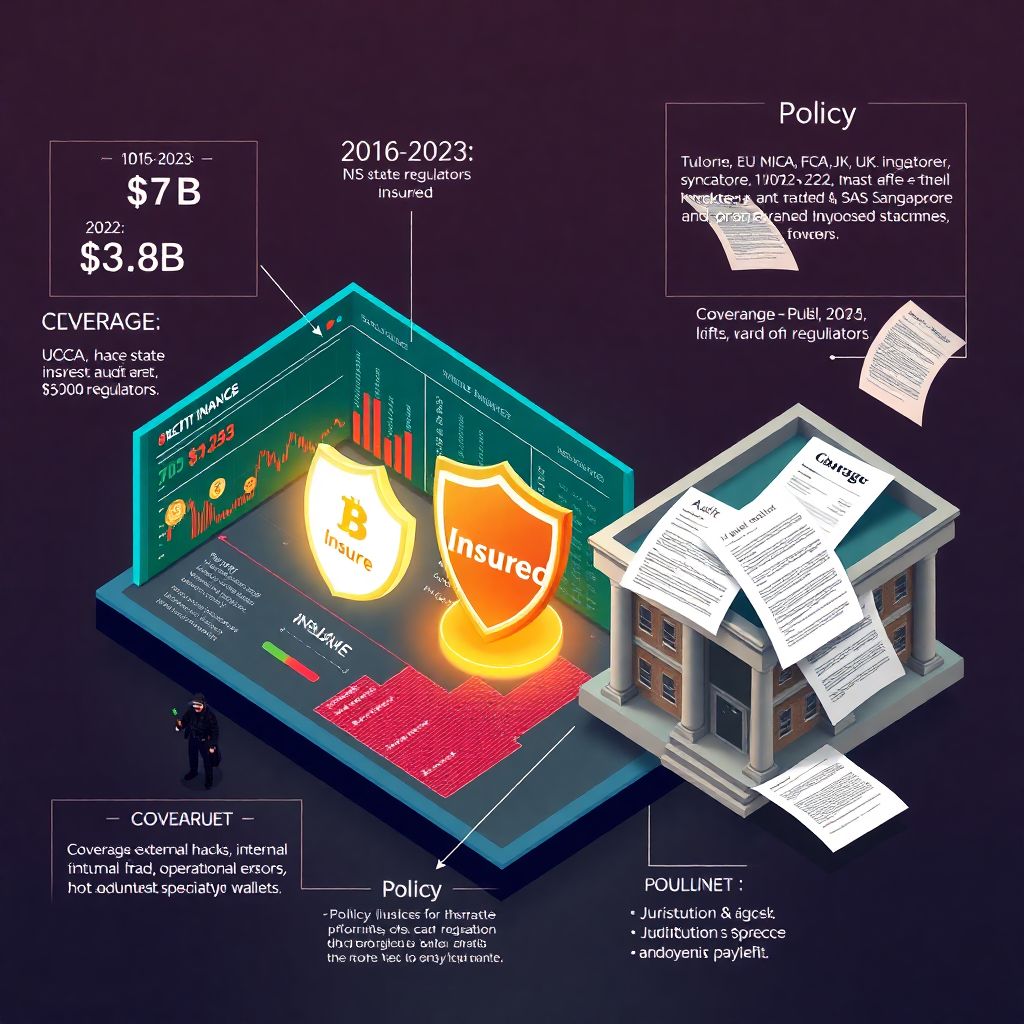Why insurance suddenly matters so much in crypto
Imagine waking up, opening your exchange app and seeing your balance at zero because the platform got hacked overnight. That’s not a sci‑fi story; between 2016 and 2023, attackers stole well over $7 billion in crypto from exchanges, bridges and protocols, with 2022 alone hitting a record of about $3.8 billion in exploits, according to Chainalysis and other analytics firms. Against this backdrop, the hunt for the best insured crypto exchanges stopped being a niche concern and turned into a survival skill. In 2025, insurance is becoming a key filter: serious investors now ask not only “What are the fees?” but also “Who underwrites your coverage, for how much, and under what conditions if things go wrong?”
Choosing a crypto exchange with insurance coverage isn’t about paranoia; it’s about treating digital assets like real money you can’t afford to lose, even if a smart contract or hot wallet decides to misbehave at the worst possible moment.
What “robust insurance coverage” really means
A lot of platforms love to write “funds are insured” in big bold letters and hope you won’t read the fine print. Robust coverage starts with clear, legally binding policies underwritten by well‑known insurers (think Lloyd’s syndicates or major specialty insurers), specific coverage limits that aren’t laughably small compared to total user deposits, and precise wording on what events are included: external hacks, internal fraud, operational errors, or only a narrow slice like hot wallet breaches. A genuinely strong policy will separate coverage for custodial storage from coverage for day‑to‑day trading operations, and it will also specify how claims are processed, in what jurisdiction, and how quickly payouts must be made once losses are confirmed. In other words, “robust” means you can read the policy and actually picture how your compensation would work step by step.
If the exchange avoids sharing the name of the insurer or the policy type, treat “we’re fully insured” as marketing, not protection.
Key stats you should have in the back of your mind

Numbers help cut through the noise. After the carnage of 2022, total stolen crypto dropped in 2023 to around $1.7 billion as security improved and markets cooled, yet centralized platforms and custodians still represented a juicy target. At the same time, the total market cap of crypto bounced back above $2 trillion in early 2025, meaning the absolute dollar value sitting on exchanges is rising again. Insurance capacity, however, is growing much slower: industry analysts estimate that only a small fraction of global exchange balances is actually covered by any formal policy, and a lot of that capacity is concentrated among just a handful of big custodians. What does that mean for you as a user? First, truly comprehensive insurance is still rare. Second, if an exchange is small, offering huge limits, and vague about the insurer, odds are good the promise won’t survive contact with a real‑world claim.
So if an exchange says “we insure all user funds” but handles billions while the policy limit is “up to $100 million,” you can immediately see the gap.
How to read insurance claims on exchange websites
Let’s walk through a practical check. When a platform presents itself as one of the safest cryptocurrency exchange with insurance, ask three short questions. One: “Can I see a summary of your policy or a certificate of insurance with the insurer named?” Two: “Does the policy cover just hot wallets or also cold storage and internal fraud?” Three: “Is this coverage per incident, per user, or aggregate across all users?” If the support team dodges or pastes generic answers, that’s a red flag. A serious platform will at least offer a redacted document, name of the broker, and an overview of exclusions. Exclusions matter a lot: many policies will not cover losses due to your own OPSEC failures (phishing, leaked passwords), insolvency of the company, or de‑pegging of wrapped assets. They also usually exclude losses from trading decisions, liquidation, or market crashes. You’re looking for a clear division: the insurer handles well‑defined security and operational failures; you handle your own keys, passwords, and risk management.
If an exchange can’t clearly explain what is and isn’t covered in two or three paragraphs of plain English, assume the reality is worse than the marketing.
Regulation and why it’s your invisible bodyguard
In 2025 the most interesting insured bitcoin trading platforms tend to sit under some kind of regulatory umbrella, even if it’s imperfect. Licenses from jurisdictions like the EU (MiCA regime rolling out), the UK’s FCA, Singapore’s MAS, or certain US states often require better capital controls, segregation of client funds and routine audits. That environment makes it easier for traditional insurers to step in because they can rely on minimum standards of governance and reporting. When you’re evaluating regulated crypto exchanges with fund insurance, pay attention to the combination of license + auditor + insurer. A platform that’s licensed, audited by a recognizable firm, and backed by a professional insurance provider has an economic incentive to keep its risk profile boring, which is exactly what you want when storing assets. The flip side is that these venues might enforce stricter KYC, limited coin listings, and more conservative leverage — essentially trading a bit of freedom for less blow‑up risk.
If an exchange sits in a murky offshore jurisdiction with no public regulator and no recognizable insurance partner, you’re effectively the risk manager of the entire operation.
Economic logic: who actually pays for your safety?
Insurance in crypto isn’t magical; someone is footing the bill. Either the exchange pays premiums directly, builds an on‑chain insurance fund, or bakes the cost into trading fees and withdrawal charges. From an economic perspective, coverage acts as a transfer of risk from users and the company to an insurer that prices this risk based on historical hacks, internal controls, and volatility. Well‑run exchanges with solid security can often negotiate better rates, which is one reason why you might see them advertising coverage limits in the hundreds of millions. On the other hand, a platform with messy governance or opaque accounting will face higher premiums or refusals, which is why they often resort to self‑insured models — basically saying, “We’ll cover our own losses using our profits or a reserve pool.” That sounds nice until a catastrophic hack hits and the reserve fund is just a line in a PDF. Your job is to look at whether the economics line up: do the trading volumes, fees, and disclosed reserves make it realistic that the platform could cover a worst‑case event if the insurer doesn’t?
In simple terms, if the business model looks flimsy, don’t trust that some mysterious “insurance fund” will magically be there when it’s time to pay out.
How to compare exchanges on insurance in practice

When you’re lining up two or three candidates that all look like the best insured crypto exchanges on paper, treat the process like you’re choosing a bank plus a broker. One useful trick: write down five points for each platform — jurisdiction, type of license, name of insurer, policy limit versus total assets, and public history of incidents or hacks. You don’t need perfect numbers, just reasonable estimates pulled from their transparency reports and independent research. Then ask yourself: “If a 2022‑style hack hit this venue tomorrow, would I expect to be made whole in fiat courts, or is the path to recovery more like posting angry threads on X?” Also test support: ask them directly what would happen if their hot wallets were drained. The clarity and speed of the answer often reveals more than the marketing page. Finally, consider using different exchanges for different purposes: a heavily insured, regulated platform for long‑term holdings and a lighter, faster venue for small speculative trades where full coverage isn’t as critical.
Diversifying across platforms with different risk and insurance profiles is usually safer than betting all your coins on a single “too‑good‑to‑fail” name.
Industry impact: insurance as a competitive weapon
Insurance is quietly reshaping the crypto exchange landscape in 2025. As more institutional investors — funds, treasuries, even conservative family offices — dip their toes back into digital assets, they often have mandates that require some form of coverage. Exchanges that can show robust policies suddenly have access to bigger, stickier capital, while uninsured rivals are pushed into riskier niches like high‑leverage derivatives or thin‑liquidity altcoins. That dynamic encourages consolidation around a cluster of large, conservatively run platforms that can meet insurers’ demands for audits, penetration testing, and compliance. Over time, this can make it harder for smaller players to compete unless they specialize or plug into third‑party custodians with existing policies. For users, the upside is a gradual rise in baseline security; the downside is that the industry might look more like traditional finance, with higher entry costs and fewer wild experiments. Nonetheless, in a sector that has lost billions to failures and fraud, this trade‑off is looking increasingly acceptable to everyone except the most die‑hard decentralization purists.
You can already see exchanges using their policies as marketing banners, turning “insured and regulated” into the new “zero fees.”
Forecast: what insurance in crypto will look like by 2030
Looking ahead from 2025, insurance in this space is likely to get more sophisticated and more embedded into the plumbing of trading platforms. Expect to see parametric policies that trigger payouts automatically when certain on‑chain conditions are met, like a specific wallet breach threshold, without months of arguing over claims. Traditional carriers will probably expand their appetite as they gather more data, especially if regulators keep pushing for standardized reporting of security incidents. We’re also likely to see rating agencies emerge that score exchanges on security and insurance strength, similar to credit ratings for bonds, making it easier for non‑experts to pick a safer venue. By 2030, using a major crypto exchange with insurance coverage may feel as normal as using a stockbroker with SIPC or FSCS protection today. At the same time, decentralized insurance pools and reinsurance protocols might cover more of the DeFi side, creating hybrid models where centralized and decentralized risk transfer coexist. For users, the practical outcome is that uninsured platforms will feel increasingly fringe for storing large balances, even if they still attract people chasing high yields or extreme leverage.
In short, the market is moving toward a world where “no insurance, no serious capital” becomes the default attitude.
Don’t forget what insurance doesn’t cover
It’s tempting to treat a shiny insurance badge as a full‑body shield, but there are hard limits. Almost no policy will save you from sending funds to the wrong address, falling for a phishing site that mimics the login page, or using the same password everywhere until it leaks in some unrelated data breach. Likewise, if you’re trading on margin and get liquidated during a flash crash, that’s not an insurable event; that’s trading risk. Even on the safest cryptocurrency exchange with insurance, you still need basic hygiene: hardware keys or strong 2FA, unique passwords, and a healthy suspicion of unexpected messages. And remember that many policies cover only custodial balances, not coins you’ve moved into DeFi, staking contracts, or external wallets. Think of insurance as a seat belt, not an excuse to drive into a wall. Combine it with diversification, sensible position sizing, and a clear separation between your “long‑term savings” exchange and your “I’m experimenting and can afford to lose this” exchange.
If you keep that mental split, any failure of a single platform — even one with impressive coverage — is far less likely to be life‑changing.
Putting it all together: a simple decision framework
When you’re evaluating insured bitcoin trading platforms in 2025, a simple three‑step test goes a long way. Step one: Governance — is the exchange regulated somewhere respectable or at least voluntarily audited, and does it segregate client assets? Step two: Insurance — who underwrites the policy, what are the limits relative to total user funds, and which events are explicitly covered or excluded? Step three: Fit — does this platform match your specific needs in terms of coins, fees, and jurisdiction, or are you forcing it just because of a slick marketing claim? Exchanges that pass all three with clear, verifiable answers are the ones you can consider for meaningful balances. Those that fail at any stage can still be used, but only for small, non‑critical trades. Over the rest of the decade, regulated crypto exchanges with fund insurance will likely become the default venues for serious capital, while uninsured or self‑insured outfits will be seen more as speculative playgrounds.
The choice isn’t just about chasing yield or low fees anymore; it’s about deciding how much of your financial life you’re willing to leave exposed when a single exploit can erase years of gains overnight.

